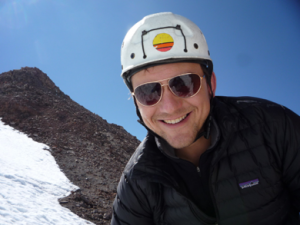fun version
I ran away from my NY home at the age of 18, ended up in New Orleans and was educated by brass-band funk and dive-bar fixtures. The United States Government thought those skills would benefit their continued occupation of post-WWII Europe, so they sent me overseas. My education continued…terroir, appellation, and over 3.2 million lbs of bombs on target. Jumping ship in ’06 I was rescued by academic mitten mercenaries, where I toiled in their indentured servitude until achieving doctordom in twenty-eleven. Post-matriculation, I packed up my tweed and headed west to the land of silicon opportunity. After four years of Farm livin’, the stormy, husky, brawling city of the big shoulders brought me back, halfway to home, henceforth to profess.
less fun, more hyperlinked version
I’m originally from a small town in upstate New York…Grafton, known for its state parks and the ‘most uneven surface of any town’ in the county of Rensselaer. I spent my youth running through the woods, tending to my mother’s Toggenburg goats, and patiently learning to fish from my father and older brothers. My teens brought me to La Salle Institute of Troy, NY, where I cliqued with fellow ‘schoolies’. Summers were spent learning the vagaries of atmospheric circulation, watching Green Mountains sunrises and Adirondack sunsets, and desperately seeking Champ while sailing Lake Champlain.
Semi-random chance and ROTC sent me to Tulane University in New Orleans, Louisiana for my undergraduate education: Tipitina’s, The Maple Leaf, Jaques-imo’s, Mardi Gras, Jazz Fest and physics! In the midst of my nola education I managed to slip away for a year, to Whidbey Island in Puget Sound, for a stint on an Americorps team that was equal parts trail crew, experiential primary school education, and self-discovery through adventure sports.
When the Pacific northwest fun was over, I went back to nola to finish up my degree, supplementing my Physics B.S. with as many classes from the Geology department as allowed. Graduation saw me enter the Air Force to pay back the uncle that had funded my four year stint in the crescent city. My first assignment as a second lieutenant in the AF was earning an atmospheric science degree at Texas A&M University in College Station. That degree landed me a job in the US Air Force European forecasting hub in Sembach, Germany. There, NCO’s of various stripes taught me the craft of forecast, synoptic, and aviation meteorology, while my fellow officers taught me the craft of blending in with the locals by wearing short leather pants. Following Deutschland, I headed south to Aviano Air Base, Italy, where I had the pleasure of interacting with fighter pilots on a daily basis…which facilitated my decision to head back to academia.
In seeking a graduate education I had the notion that I wanted to combine my undergraduate passion for geology with my newly learned trade, meteorology. Chris Poulsen’s lab group at the University of Michigan proved to be the perfect fit. Using climate models, my dissertation research explored the late Paleozoic ice age, a period some 300 million years in Earth’s past. This project sent me to Argentina for a brief foray into the art of field work and then taught me the tools of numerical climate modeling. While at Michigan I also discovered a passion for teaching, particularly teaching in the field. Summers spent interacting with students at the Camp Davis Rocky Mountain Field Station (the happiest place on Earth) in Jackson Hole, Wyoming demonstrated the inspirational power of experiential education.
Upon receiving my doctorate from Michigan, I sought to expand my academic horizons beyond the realm of paleoclimatology and found employ with Noah Diffenbaugh at Stanford University. Working in Noah’s group allowed me to use my knowledge of climate science to address contemporary environmental issues. While at Stanford, I learned and applied new analysis techniques in an effort to understand the potential effects of climate change on air quality meteorology, disease vector evolution, and high-impact extreme weather events.
In the Fall of 2015 I left the Farm to join the Northwestern University faculty in the Department of Earth, Environmental, and Planetary Sciences. There, the incredibly creatively named research group, the Climate Change Research Group, was founded. The CCRG studies Earth’s climate system across a myriad of spatiotemporal scales, investigating subjects whose diversity is limited only by our imagination, creativity, and ingenuity. The driving focus of the CCRG is to examine Earth’s climate system through multiple lenses, each designed to build a better understanding of how the Earth system works, how the impacts of climate change are mediated, and how this knowledge might be used to improve societal preparedness and resilience in the face of climatic change.


